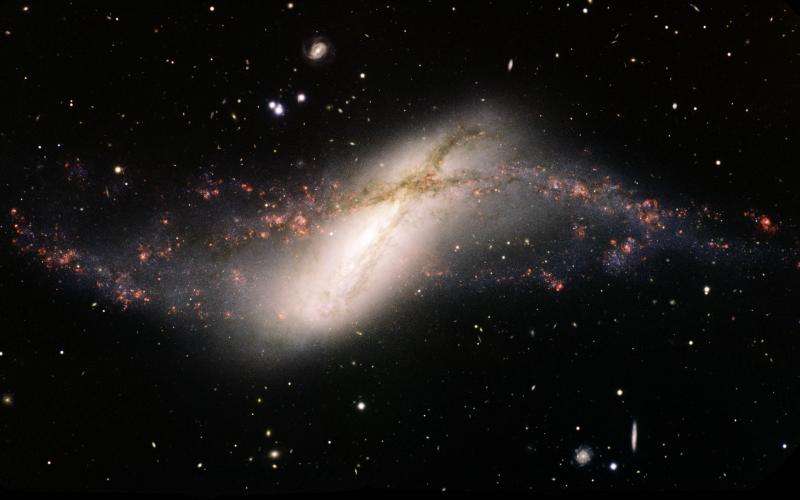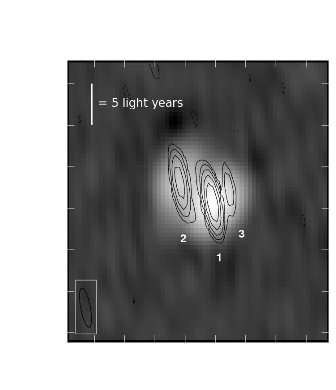Radio astronomers see black hole come to life

42 million light years away, 20 million times the mass of the Sun, and coming back to life. A team of radio astronomers, led by Dr Megan Argo of the Jodrell Bank Centre for Astrophysics, are watching a previously dormant black hole wake up in a dramatic display as material falls on to it for the first time for perhaps millions of years. Dr Argo reported their work today (9 July) at the National Astronomy Meeting at Venue Cymru, in Llandudno, Wales.
Almost every galaxy, including our own, appears to have a black hole at its core. Most of the time these are quiet, with just their invisible gravitational pull shaping their surroundings. But in about 10% of galaxies the central black hole is much more active, swallowing material and spitting out giant jets. For the first time, the new study shows convincing evidence of the onset, the 'switching on' of this active phase, in a black hole at the centre of the galaxy NGC 660, 42 million light years away in the constellation of Pisces.
NGC 660 is a stunning example of a polar ring system galaxy. Like most galaxies, it has a thick disk of stars and gas. But NGC 660 also hosts a larger and much less dense ring of stars and smaller star-forming clouds, in orbit over its poles. This additional ring is thought to be the remnants of a past encounter with another galaxy that disrupted both systems.
In 2012, astronomers carrying out a survey with the Arecibo radio telescope in Puerto Rico noticed that NGC 660 had suddenly become hundreds of times brighter over just a few months. Normal galaxies do not change their brightness very quickly as they are very large systems made of many (relatively) small individual components in the form of stars, gas and dust. Though all of these may change dramatically, the average brightness of a galaxy tends to be very stable.
The earlier results mean that one particular object within the galaxy has undergone a significant change and become much brighter, and the likely culprit is either an exploding star, or the central supermassive black hole. But the Arecibo observations could only hint at what was happening.

Over the last three years, a team of scientists led by Dr Argo has been trawling through archived results from ground- and space-based telescopes. They then used three radio observatories: the UK's e-MERLIN telescope operated from Jodrell Bank, the Westerbork array in the Netherlands and the European VLBI Network (EVN), which also includes telescopes in Russia, China and South Africa.
Individual radio dishes have very poor resolution, so astronomers link widely spaced telescopes together to simulate a much larger instrument – a technique known as interferometry. With the various networks of telescopes working in this way, the team could then look at NGC 660 in detail.
The new images show features about a light year across, about a quarter of the distance between the Sun and Alpha Centauri, the next nearest star. They reveal a new, very bright radio source in the very centre of NGC 660, right where we expect to find the central supermassive black hole.
Inactive black holes do not emit large amounts of radiation, so we can only detect them by their gravitational effect on the orbits of stars around them. But the black hole in NGC 660 is now very obvious, and is many hundreds of times brighter than anything seen in the centre of NGC 660 in the archive of radio images before 2010.
Dr Argo said: "Many examples of galaxies with active black holes are already known, often with massive jets stretching millions of light years into intergalactic space. But NGC 660 is special – for the first time we can see this activity starting up."
The Westerbork observations let the team use this new strong radio source to probe the normally opaque clouds of hydrogen gas within the galaxy, shining a 'torch' through the clouds to see what they are made of. The parallel results from e-MERLIN show that the object is slowly fading, and is similar to other galaxies with more mature systems, and the highest resolution images from the EVN show evidence of a high-speed jet of material leaving the vicinity of the black hole.
Material (gas, dust and stars) near a black hole can sit in stable orbits around the central massive object for a long time, but eventually it loses energy, spirals in, and falls onto the black hole. At the same time, some material is ejected and this seems to have created the outburst and jet now seen in NGC 660.
Material in the jet is very fast, travelling at about 10% of the speed of light. Dr Argo explained: "Nothing on Earth has anything like the energy of a jet leaving a giant black hole. Because it moves so quickly, we should be able to watch the material travelling out over the next few years and measure its speed and energy. The big question is whether it has enough energy to overcome gravity, and punch its way out of the galaxy, or if it will fizzle out before getting that far."
Studying the jet will give astronomers a clue about the initial eruption of the jet, and how much material fell onto the black hole to cause the outburst in the first place.
Provided by Royal Astronomical Society





















